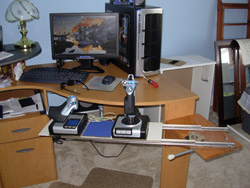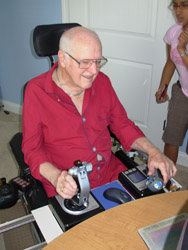Designers: Alexa Issa, Neha Krishnamohan, and Swara Paranjape
Supervising Professors: Kevin Caves and Richard Goldberg
 INTRODUCTION
INTRODUCTION
Our client is an active retiree with a slow progressing form of Amyotropic Lateral Sclerosis (ALS). He worked in the aerospace industry, and now enjoys playing flight simulator computer games. He uses a wheelchair for mobility and has limited strength in his arms. He has special flight controls that allow him to more realistically control the simulator. These flight simulator controllers had been mounted to a plywood base. Due to his weakened arms, however, it became difficult for him to switch between using the flight simulator controllers and using the computer keyboard and mouse. We developed a device that provided for ergonomic positioning of the controllers, mouse and other equipment needed for the flight simulator game. The device also is easily stored when the computer was needed for other activities.
 SUMMARY OF IMPACT
SUMMARY OF IMPACT
The client stated that “it’s going to make it just a lot easier, because my hands are lower to start with, and I am more relaxed because usually I am sitting up at my computer desk and now I can sit back and still move the controls around, it is going to be a big help. The system is great for me as I now can easily move my hands onto the controls as they now sit at a level that is comfortable with my arms resting on the wheelchair arm rests. Also, as it is closer to my body, I am better positioned in my chair- not having to lean forward to reach the controls when they were on the computer table before. Having the place for the mouse between the control elements makes it easy to access the on-screen icons to make changes in the flight simulation conditions such as weather, location, plane selection, etc. I can sit back and still move the controls around, … This project has made my continued enjoyment of flight simulation possible for a long time to come.”
TECHNICAL DESCRIPTION
The Flight Simulation Station (Figure 1) is made from an acrylic tray that holds the flight simulator controls. When not in use, the tray can slide and pivot to a storage position using two drawer slides and a lazy Susan pivot. The lazy Susan is attached to an oak platform, which is bolted into the client’s computer desk. The device is designed so that the client can rotate and slide the flight controls independently and at the most comfortable position. This allows him to easily switch between using the flight controls, and using the standard keyboard and mouse.
The device is attached to the right side of his computer desk. The 25” by 7.25” acrylic tray rotates thru an angle of about 110 degrees on the lazy Susan, and extends 20” on the two drawer slides.
To make the device stable, a docking platform was attached to the left side of the client’s wheelchair. The left edge of the acrylic tray slides into this dock and holds the tray and control steady. The right side also has a locking bar that prevents rotation of the tray while in use. Additionally, pair of rollers was attached to the underside of the oak support that provides a counter force to resist the moment of the extended tray.
The flight simulator controls are attached to the acrylic tray via Velcro. The system enables the client stowed and extended his controls independently and with ease. Figure 2 shows the client using the Flight Simulation Station. Cost of parts for the device was approximately $217.